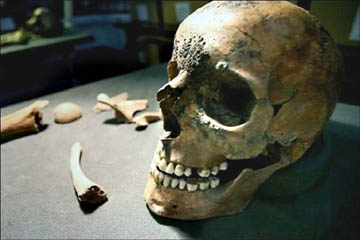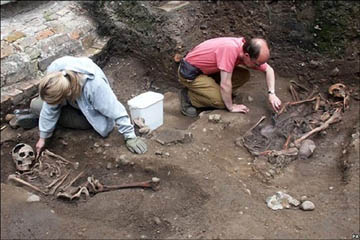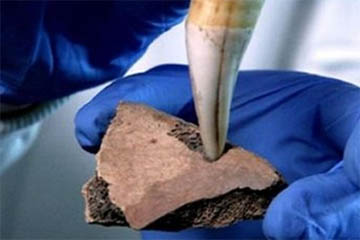A Lion's Bite solves a Puzzle
There was considerable excitement a couple of years ago when archaeologists at Ephesus, in western Turkey, announced that they had discovered a gladiators' graveyard. As the Hollywood blockbuster, "Gladiator", was still fairly hot news, the announcement stirred up more interest among the public than it might otherwise have done, but it was still worth anyone's attention.
In particular, people were horrified by the confirmation of a practice attested in the literary sources but for which proof had never been found: according to various descriptions of gladiatorial "games", at the conclusion of each bout a figure dressed as Charon, gate-keeper to the Underworld, would approach the fallen gladiator and check whether he was shamming. These days I suppose we would use brain scans and heart-rate monitors, but the ancients were far cruder - though probably no less effective. Charon was accompanied by a portable brazier in which a couple of iron rods were being heated. The red, glowing end of one of the rods was applied to the prostrate gladiator to see whether he twitched or not.
If he did, Charon made a swift assessment of his condition. If he seemed badly enough wounded to justify ending the fight but the wounds were not mortal, he would be carried away to be repaired. If, however, the wounds were more serious or, more importantly, if they would prevent him fighting again - the loss of a limb, for example - then Charon had a long handled hammer with which he would strike the gladiator on the side of the head, killing him instantly.

|
| One of the skulls found at York shows cracks on the side which could have been caused by a blow from Charon's hammer. |
A number of the skulls found at Ephesus bore the characteristic square hole made by Charon's hammer in the side of the head, just above and in front of the ear. This, more than anything else, confirmed that the bodies were those of gladiators, not soldiers or victims of violent crime.
Now archaeologists in York are leaping on the bandwaggon with the news that they, too, have discovered a gladiators' graveyard, containing as many as 80 skeletons of men who met a violent death. To their delight, several of the skulls showed fractures in the appropriate locations (though none were the square holes discovered at Ephesus).
The odd thing is that this news has been reported in Diggings previously (back in 2005), except that in our first report we stated that the 80 victims were soldiers who had picked the losing side in a coup mounted by Caracalla against the Emperor Severus in AD 211. This was the claim made by the archaeologists, who noted that the bodies were all those of young men and a number of them had been decapitated, which was the approved form of punishment for Roman citizens.
Since then, the archaeologists have been studying the skeletons more intensively, seeing how much information they could wring out of arcane things like the size of attachment points for ligaments and muscles, patterns of wear on the joints, the make up of the enamel on the teeth and so on. They noted that many of the bodies had right arms whose bones were heavier than their left arms and the attachment points were larger and more robust. This indicated that the men had been used to handling heavy weights - but only with their right arms; in other words, they had wielded weapons, probably from a young age.

|
| Archaeologists in York have uncovered 80 skeletons in the garden of an 18th century mansion and believe that they were gladiators. |
Roman soldiers certainly trained hard, but they only joined up as adults and trained with wooden weapons. Gladiators, on the other hand, frequently started training while still young teenagers and were commonly given extra-heavy dummy weapons specifically to strengthen their muscles.
However it was always possible that these men had belonged to an extra-keen regiment or something. Even the fact that fourteen of the bodies were buried with grave goods did not prove that they were anything other than executed legionaries: their bodies might have been tended by relatives from the township.
The discovery that lead the team of archaeologists and forensic scientists to conclude that these were gladiators was an odd hole in one of the bones. It wasn't sharp-edged, as you would expect to find in a wound from a spear or arrow; it was rounded at the bottom, which was also unlike a wound from a sharp-pointed spear or arrow; above all, the bone around it was fractured in a way which indicated an intense but slow-moving force.
The study of fractures in hard substances is an interesting one. Next time you see a bullet hole in glass notice that the round hole of the bullet is surrounded by a circle of damaged glass that slopes in towards the hole. Contrary to what you might expect, the faster the bullet was travelling, the smaller that area of damaged glass! This is because the area of damage spreads out while the bullet is travelling through the glass, so the faster the bullet, the less time there is for the damage to spread out.
Knowing the size of the hole, the police can measure the area of damage and calculate how fast the bullet was travelling, which will not only tell them the sort of weapon used (which they could probably judge from the size of the bullet hole) but also how far away the shooter was standing when he fired, for a bullet slows as it travels through the air.

|
| A lion's tooth matches the hole in the bone almost exactly - and as wild animals were not common on the battle field, the wound makes it almost certain that this man died during a 'games' to entertain the Roman mob. |
Although an arrow travels very much slower than a bullet, the same considerations apply and the area of fractured bone that surrounds an arrow wound will be very much smaller than that around, say, a spear thrust. In the case of the York skeleton, however, the area of fractured bone was large and that, together with the appearance of the wound, led the team to conclude that it was caused by an animal's tooth - lion, tiger or bear.
There were bears in Britain, but by Roman times they were few and far between and the chances of a Roman soldier being killed by one within the environs of Eboracum were so small as to be impossible. In addition, the scientists managed to borrow a lion's tooth from a local museum and found that it was an almost exact match for the wound they were studying. As there are no lions in Britain, that meant that the wound was caused by an imported beast, almost certainly brought to York as a "star turn" in a gladiatorial games which commonly included a wild beast hunt or a combat between a gladiator and an animal such as a lion or tiger.
Needless to say, the archaeologists, one eye on future funding, are loudly proclaiming that this is "the world's best preserved gladiator burial ground", even though when you read the small print, you discover that they are still not 100% certain that the bodies are gladiators. It seems likely, but other explanations are still possible and it will take several more years of study to extract all the information possible from the eighty skeletons found so far.
a bullet hole in glass Not as unlikely a spectacle as you might think, particularly if you attend a church. Unattended buildings such as churches or schools appear to act like a magnet for every brainless teenager whose thick-headed parents have given him an air gun. No sooner is the wrapping paper off and a supply of pellets to hand than he makes a beeline for the nearest church or school and proceeds to shoot at the windows.
Given that most of my readers will be evolutionists rather than creationists, I have never understood why the death penalty was abolished for offences such as this. Removing such morons from the gene pool would probably double the average IQ of the population at large and can only improve our prospects for survival as a species. Return
© Kendall K. Down 2010





